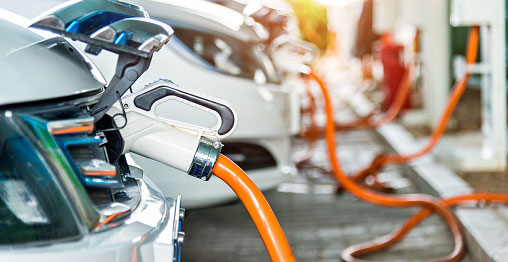State Planning and Funding for Electric Vehicle Charging Infrastructure
State governments play an important role in the planning and implementation of electric vehicles (EV) and EV charging infrastructure. Specifically, the Bipartisan Infrastructure Law (BIL) (Public Law 117-58), signed by President Biden in November 2021, provides funding to build out a national EV charging network. In addition, investments from the BIL will deliver electric school and transit buses across the country. These investments will drive demand for American-made batteries, vehicles, and infrastructure, creating jobs and supporting domestic manufacturing. States play a key role in implementing these investments by developing plans, offering incentive programs, and identifying and distributing funding.
The following table summarizes major BIL programs that assist states in their electrification efforts. Visit the U.S. Department of Energy's (DOE) BIL Programs for a review of new DOE programs.
The Federal and State Laws and Incentives database is another resource for federal and state incentives and regulations related to alternative fuel vehicles and infrastructure. Further, DOE's Battery Policies and Incentives Search tool provides summaries of battery programs under the BIL, and other federal and state legislation.
| Program | Amount | Administering Agency | Summary |
|---|---|---|---|
| National Electric Vehicle Infrastructure (NEVI) Formula Program | $5 billion | U.S. Department of Transportation (DOT) Federal Highway Administration (FHWA) | The NEVI Formula Program provides funding to states from fiscal years (FY) 2022 through 2026 to procure and install EV chargers with the goal of building a national network of EV chargers. The NEVI Formula Program targets charging along corridors and Interstates. |
| National Alternative Fuel Corridors | FHWA | FHWA designates a national network of EV charging and hydrogen, propane, and natural gas fueling infrastructure along national highway system corridors. To designate these Alternative Fuel Corridors, FHWA solicits nominations from state and local officials and works with other federal officials and industry stakeholders. | |
| Charging and Fueling Infrastructure Grants | $1.25 billion | FHWA | The Charging and Fueling Infrastructure Grant Program provides funding from FY 2022 through 2026 to install EV charging and alternative fuel in locations on public roads, schools, parks, and in publicly accessible parking facilities. These grants will give priority to projects in rural areas, low-and moderate-income neighborhoods, and communities with low ratios of private parking, or high ratios of multi-unit dwellings—also called multi-family buildings. |
| Public Transportation Research, Demonstration, and Deployment Funding | $5.6 billion | DOT Federal Transit Administration (FTA) | The Low- or No- Emission Bus Grants provides capital funding from FY 2022 through 2026 to help transit agencies transition to low- or zero-emission transit buses and purchase fueling and maintenance infrastructure. For more information, visit the FTA Low or No Emission Vehicle Program website. |
| Clean School Bus Program | $5 billion | U.S. Environmental Protection Agency (EPA) | The Clean School Bus Program provides grant funds from FY 2022 through 2026 for zero-emission and low-emission school buses. For more information, visit the EPA Clean School Bus Program Funding website. |
| Carbon Reduction Program | $6.4 billion | FHWA | From FY 2022 to 2026, states may use formula grants through the Carbon Reduction Program for projects that support the reduction of transportation emissions. |
| Battery Materials Processing, Production, and Recycling Grant Program | $3 billion | DOE's Office of Energy Efficiency and Renewable Energy (EERE) and Office of Manufacturing and Energy Supply Chains (MESC) | Battery Manufacturing and Recycling Grants are available from FY 2022 until funding is expended to support a North American battery supply chain, including demonstration projects, construction of commercial-scale facilities, and retrofit or retooling of existing facilities for battery component manufacturing, advanced battery manufacturing, and recycling. For more information, see the funding opportunity announcement. |
| Battery Materials Processing Grants | $3 billion | EERE and MESC | Battery Materials Processing Grants are available from FY 2022 until funding is expended to support a North American battery supply chain, including demonstration projects, construction of commercial-scale facilities, and retrofit or retooling of existing battery material processing facilities. For more information, see the funding opportunity announcement. |
| Electric Drive Vehicle Battery Recycling and Second-Life Applications | $200 million | EERE | Funding for Battery Recycling and Second-Life Applications is available from FY 2022 until funding is expended for research, development, and demonstration of EV battery recycling and second-life applications for vehicle batteries. For more information, see the funding opportunity announcement. |
The following resources assist states with the implementation of transportation electrification programs under the BIL.
Joint Office
The Joint Office of Energy and Transportation (Joint Office) is an interagency collaboration between DOE and DOT that supports a nationwide effort to develop the infrastructure necessary for widespread EV adoption. The Joint Office provides support and expertise to a multitude of BIL programs that seek to strategically and equitably expand EV charging infrastructure, zero-emission fueling infrastructure, and zero-emission transit and school buses. Visit DriveElectric.gov for technical assistance, tools and data, and guidance resources from the Joint Office.

The Joint Office supports state-level efforts to install, operate, and maintain EV infrastructure as part of the Biden administration's goal to facilitate a national network of up to 500,000 EV chargers.
EV States Clearinghouse
To complement DriveElectric.gov, the EV States Clearinghouse is a one-stop shop for state agencies as they plan for and implement EV infrastructure programs under the BIL. This site is a repository for EV program documents from states, current state-level EV roadmaps, and other resources, and will provide guidance on how these resources may help with BIL implementation. State agencies must register for a free account to access the Clearinghouse.

